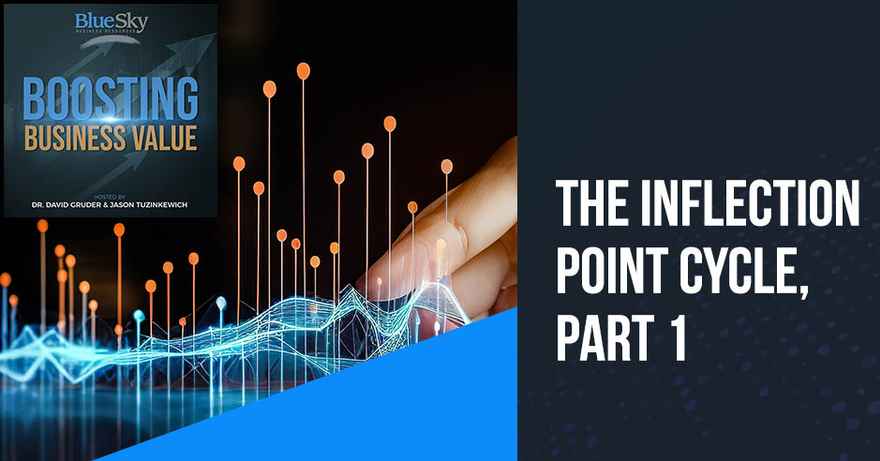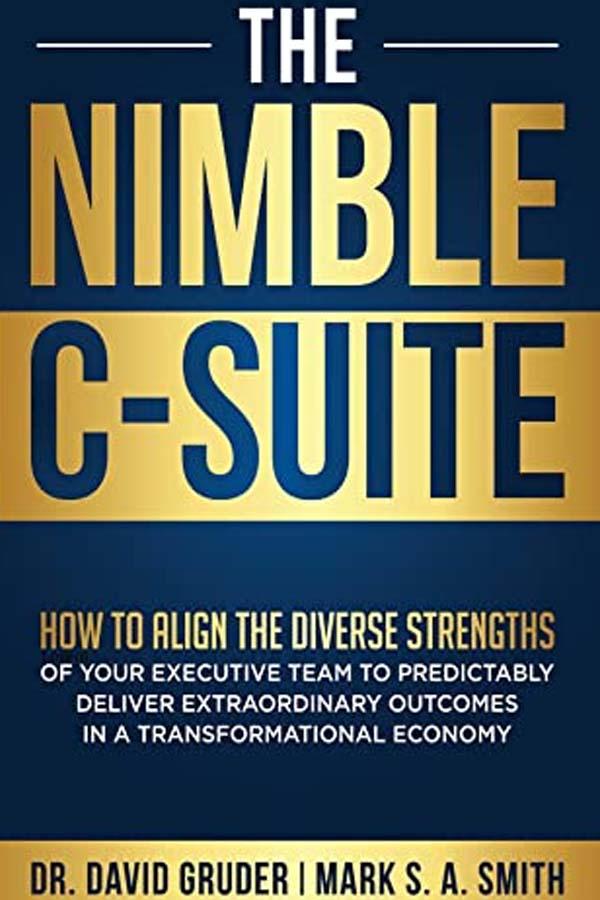Ep 25 - The Inflection Point Cycle, Part 1

Mastering the art of inflection points is the compass guiding businesses through innovation, fruition, and bifurcation—the stages of growth that lead to lasting value and triumphant exits. Welcome to the first episode of our four-part mini-series that unravels the three critical "Inflection Points" that every successful business must master to achieve longevity, robust growth, and a rewarding exit. In "The Inflection Point Cycle, Part 1," your hosts, Dr. David Gruder and Jason Tuzinkewich dives into the concept of inflection points and their transformative impact on businesses. Together, they discuss how inflection points are major pivot points where strategies, tactics, organization, and leadership must evolve, marking the phases of innovation, fruition, and bifurcation. They draw parallels between these inflection points and the stages of a business's life cycle, highlighting the dynamic nature of growth and adaptation. Join us as we unravel the significance of inflection point mastery in boosting your business's value. Your journey to mastering the art of business growth starts here.
---
Listen to the podcast here
The Inflection Point Cycle, Part 1
How Durable Businesses Successfully Navigate Three Developmental Pivot Points
In this episode, we're going to begin a four-part series on the three inflection points that all businesses must master to achieve durability and long-term growth. Doctor, it's great to have you again.
It's great to be had and it's great to be with you.
Tell us about this inflection point concept, Doctor.
I shall do exactly that. As we like to do in these episodes, when we introduce terms that might not be in common usage or at least commonly used in the way we're using them in a particular episode, we're going to define what we mean by inflection points for the purpose of this four-part series. We view inflection points as major functional pivot points where strategy, organization, tactics, and leadership requirements must change. Not optional but absolutely mandatory.
Let's talk about what these inflection points are. One of the things that is going to come out as we talk about this over the next four episodes is that these are three phases that keep reoccurring. This is a cycle, not a linear progression. What you'll see is innovation. If you think about a starting up business, you're innovating a product or a service and perfecting it before you can bring it to the market and share it with the world. There's a fruition stage where you've essentially perfected something or brought something to a point where you're ready to share it with the world, generate revenue, and start to streamline it. It's no longer about creation. It's about optimization. You then go to the last stage of the cycle, which is bifurcation.
Bifurcation is where you necessarily have to start innovating the next new thing but you still want to maintain the focus on quality, consistency, and durability of the original product or service that is in the fruition stage. You have to start splitting your resources, attention, and strategic mindset to be able to do both innovation and fruition. This is where it gets complicated, but it's also the beginning of the next cycle. It's those three pieces on and on again throughout the life of your business. As you can imagine, there are some pretty big challenges that you're going to face as you go from innovation to fruition from bifurcation into a new fruition stage and continuing on.
What we're going to do in this episode, because these topics are pretty complex, is we're going to complement the big challenges with some roadmap and guidance points for success. We're going to combine those two pieces of what we normally discuss in the show so that we can build upon what we're talking about. The first thing that we've recognized as a challenge is that everything that gets you to an inflection point will not get you through the inflection point.
Everything that gets you to an inflection point will not get you through that inflection point.
What we mean by that is that when you get to the point or you've innovated to the point that you're ready to launch a product, grow the business, and scale the delivery of a product or service, that process, mindset, strategic planning, the capital and resource requirements, everything is different when you're optimizing and scaling than it was when your innovating. It is being able to recognize when these inflection points show up and having the team and the organizational structure ready to hand off and say, “Here's the baton. You run with it. You're in fruition now.” That's a big thing that we're going to talk about throughout this, especially when you get to the third stage, you're bifurcating.
You need people who are experts in the innovation piece and you need an organizational structure that supports innovation while you’re maintaining an organizational structure that requires consistency and kills change. The idea that what gets you to an inflection point will not get you through the inflection point is a big deal. The success world map for that is recognizing it, being proactive, having a plan, and being willing and capable of handing off to a structure and an organizational team that excels at whatever the new inflection point is.
Well said. It’s absolutely crucial. What we're going to do now in the big challenges section of this episode is we're going to talk about the challenges and navigation in each of these three inflection points starting with the first inflection point, which is innovation. What this inflection point or innovation is about is our capacity to creatively fail forward. It's the entrepreneurial and risk-taking mindset, not imprudent risk but daring to be audacious, step outside the box, or obliterate the box entirely to bring something to the marketplace that hasn't been seen before or hasn't been seen before in the form with the features and benefits, or at the price point that you're introducing this innovation. I'm saying it that way because there are multiple varieties of innovation.
As we get into future parts of this four-part series, we'll talk about the strategy mindset, the tactical mindset, and the operational mindset that's needed in each of these navigating or inflection points. With innovation, it's the capacity to creatively fail forward and the ability to maximize limited resources. Unless you have lucked into being amazingly well funded, you're going to be on a very limited budget for doing the initial innovation because innovation ordinarily occurs before profit. In fact, it always occurs before profit with whatever you're innovating even if you've been profitable with other things before and you're diverting some of those profits into your next innovation process. Innovation is creating something new.
It's not profiting yet, so there are limited resources. My analogy for that would be the rarity of not having limited resources. It would be similar to writing a book and thinking it's going to be a bestseller. There are occasionally bestsellers out there, but the proportion of bestsellers compared to the number of books that come out onto the market is 1/10 of 1% of all the books that come out. If you're blessed with unlimited resources and innovation, good for you. If you're not, no harm, no shame, no fault, no blame. Welcome to the real world.
The other thing we're covering in these inflection points is capacity, ability, and focus. Again, with innovation, it's the capacity to creatively fail forward, the ability to maximize limited resources, and the focus on extreme cross-functionality. When you're on a limited budget, you've got ordinarily a small team with people who are wearing multiple hats because that's simply what it's going to take to get things off the ground with the new innovation.
Well said. Even the astute businesses that are flush with resources keep the resource allocation to innovation streams marginalized. They keep the minimum because they need to force that point where a decision has to be made. If you have endless resources and you believe passionately in your product, you can continue to spend those resources and not ever have to take the stern focus look at, “Is this viable? Are we creating something that can find the fruition inflection point?”
If you have endless resources and you believe passionately in your product, you can just continue to spend those resources and not ever have to take the stern focus of asking, "Is this viable? Are we creating something that can find the fruition inflection point?"
I think about Elon Musk with SpaceX. He had all the money from PayPal and Tesla, but when you talk to the engineers that were at the beginning of SpaceX, it was still on a shoestring budget and very strict deadlines because that's how you force the focus and the capacity to create a creatively fail forward. You have to accept failure in order to innovate. That's great and I appreciate you bringing that up. That brings us to fruition. The analogy that I like to point out here is fruition is when a business goes from being led by an entrepreneur to being led by a CPA. This is when the business gets very conservative about change, very focused on the minutia and the details, and focuses on quality and scalability.
Both of those things are achieving maximum quality and scalability requires that things no longer change. It requires consistency. When you're moving from innovation to fruition, you are putting the brakes on change. There may be some incremental improvements that come along, but essentially, you're saying this design is the design and we're running with it. Fruition is all about the capacity to replace change with stability and consistency and the ability to emphasize resilience over creativity. Even though you'll make some of those incremental improvements, you'll notice some things that can be fixed on the fly. You're not going to go back to the design board. You're going to improve and then focus on minimizing failure rates and maximizing uniformity.
When you want to reach scale with any product or service, the guarantee that you have to be able to uphold is that every client of yours and every person who purchases your product or service will get a predictable experience. That is how skill is achieved. The fruition point is a massive change from the innovation point. You start getting a lot more resources because you're generating revenue. You have the ability to buy equipment, increase your manpower, and scale grandly but you change or forego the ability to make major changes and disruptions in your own product or service line. That framework around the fruition stage of a business cycle is where you'll eventually hit the wall and have to go to the next inflection point. Doctor, bring us home.
When you want to reach scale with any product or service, the guarantee that you have to be able to uphold is that every client of yours, every person that purchases your product or service will get a predictable experience.
Beautifully said and set up because the third inflection point in the inflection point cycle is what we call bifurcation. What bifurcation is the capacity to harmoniously facilitate the next innovation without sacrificing current fruition. This is basically the essence of what me and my co-author of the books, The Nimble C-Suite and The Nimble Company, call Nimbility, which is the integration and the intersection of resilience and innovation. Not one over the other but both equally important and each needing to be emphasized more and less in different inflection points. In the inflection points, that's what you're doing. You're emphasizing more the innovation part of the Nimbility and the resilience part less.
Obviously, you have to build in resilience but you're not focused yet on resilience because that's what the fruition phase and inflection point are about. It is installing resilience with what's been innovated. To tie this in with some other things we've said in the past, there are, among others, two counterbalancing energies that every business has to deal with. There's the energy of transformation and the energy of stability. The transformation domain is the magician or the wizard, and the stability domain is the steward, stability, predictability, organization, and standards. A company that doesn't have a deep regard for the value of both innovation and stability, the company will not be durable if there are power struggles between the innovators and the durability.
The stability maintainers, you have a dysfunctional company when there is a deep regard for the gifts and the superpowers of both of those perspectives and collaboration in order to maximize the benefits and minimize the blind spots in both of those perspectives. That's when you get a durable company and that's basically what bifurcation has an inflection point is about because it's the capacity to harmoniously facilitate the next innovation, which is the creativity side or the magician side without sacrificing current fruition, which is the stability stewarding side of the business. That's the essence of Nimbility. Bifurcation in this inflection point is all about the ability to separate into what I was saying, stewards and innovators.

Not for them to be at war against each other but for the business to understand that in the bifurcation inflection point, you have two teams that are to an extent siloed but not cut off from each other. They're siloed only to the extent that their focus is necessarily different from the other group’s focus. You've got the ones in bifurcation. You've got the ones that are doing the next innovation while the ones who are maintaining stability and profitability with the fruition of what you've already innovated are continuing to excel at that. It’s that ability to separate into two teams that are certainly talking to each other and collaborating but their function and focus are necessarily different. As you master bifurcation as an inflection point, you're focusing on synergy between both tracks.
You don't want these two different tracks in opposition to each other, in competition against each other, or undermining each other. You want them both to be contributing to the higher good, durability, and sustainability of the business. Bifurcation can take a number of different forms. You can get bifurcation where a business stays focused on the general area that their previous innovation focuses on or it can be a new focus area or a new market segment. It can involve keeping the company together as one company or spin-offs where a new innovation is so different from the fruition in the company that you spin off a new division or you sell it off to another buyer. There are a lot of ways to navigate bifurcation. I think you should talk a little bit about the Fuji and Kodak example in that, Jason.

Most of our audience is going to be familiar with the Kodak story. The Kodak R&D Department developed the capacity for digital cameras and the Kodak executives decided that was not something they were interested in pursuing because it made their core business film obsolete. They ruled the film world and they didn't see film going away. We know how that happened but at the same time, their number one competitor which Fujifilm. They were faced with the exact same conundrum only they didn't have an R&D Department that had developed the technology that was going to make them obsolete. They knew that film was going to become obsolete because they saw digital cameras and understood what they could do.
Rather than saying, “We're great at film. We are Fujifilm,” they said, “We've been great at film. What does that expertise translate into?” While they maintained their Fujifilm arm, they bifurcated. They got this team of innovators to look at what our expertise allows us to do. They realized, “Our expertise in chemical substrates is expertise in film coding and development and our expertise in these different chemical compositions allows us a lot of mobility.” They started pursuing a bunch of tracks. Some of the tracks that they ended up successfully pivoting into are now in cosmetics. They are producing substrates and components for a lot of cosmetic companies and they're developing a lot of film coatings.
They do coatings and protectants for automobiles, shipping vessels, and myriad other things. Fujifilm is still a very strong, robust, and durable company because they were able to bifurcate. They were able to allow people to innovate within their organization and nurture that innovation without squashing it out. Whereas Kodak, the anti-Fuji, were stuck in their inertia. They were afraid to throw resources into innovating. While Kodak is still in existence, it's a mere shadow of what it was. I love the description that you gave. This characterization of bifurcation is so important because this is truly where successful industries and businesses fail. This is the part that you don't hear about enough in business conversations and in dialogue but this is where great businesses go to die.
I heard this horrible statistic that with the rate of innovation and change in our modern world, the average life expectancy of a business now is less than 40 years. That's younger than me and you. I know it's shocking for our audience but this is younger than both of us. If I were a business, I'd be dead by now based on modern statistics. It's because of this lack of understanding of these three inflection points and the lack of capacity to manage them. I'm so excited that we're going to do this series and I'm looking forward to the next three episodes.
Now that we've laid the groundwork for what we're talking about, we're going to talk about how strategies and strategic mindsets are different in these phases and how to work through that. How management expectations and requirements are different and how the organization itself has to be fundamentally different in these phases and work through.
How leadership needs to be different in each of these phases too.
Yes. Now that we've laid the groundwork for what are the inflection points what the heck are we talking about, we can talk about, as a business owner, as an advisor to the business owner, and as part of the operational team, how we ensure durability and growth because we understand these inflection points. Hopefully, you'll stick around with us. We look forward to hearing your comments and feedback as we go on this journey together. Doctor, before we sign off, what are your takeaways from this conversation so far?
It's been juicy and the first takeaway that I've got is that there is no getting around these inflection points. Ignore them at your own peril. Ignore them at the peril of your company's continued existence, profitability, and value. This is not optional. Inflection point mastery is mandatory for business durability, value, and scalability.
That's a great takeaway. That brings up in my mind the fact that you use the term mastery. I think about this as this is organizational mastery. It is a very rare human being who can master the needs, the paradigms, and the ability to facilitate success in these three different inflection points. However, understanding that organizational mastery is requisite. It brings about a new imperative or a new sense of urgency to build a team that holistically can master these inflection points and the ability to make handoffs organizationally.
Also, understand that not only are you handing off a product and a service into a new inflection point, but you're handing off an entire organizational expectation. An entirely new set of KPIs at the entire new set of metrics. Everything changes as you move through these inflection points and building a team that can master this is crucial.
That is directly connected to my other takeaway which is that handoffs are mandatory. They're not optional. Leaders and teams who excel at innovation and creativity aren't the leaders and teams who excel at fruition, stability, predictability, organization, and standards. As I said earlier, they are both absolutely crucial. The magicians, innovators, and creatives are, just as, but not more important than the stability and stewards. The people who are responsible for getting the show on the road in the first inflection point and the innovation in the flexion point need to be prepared to hand off the guidance of the ship or the business to the fruition masters when innovation has birthed the thing that that's being sold.
This is a huge takeaway because what Jason and I have seen over and over again is people who are founders of businesses who are brilliant at creativity, innovation, development, and startup. All of that entrepreneurial mindset is refusing to turn over the day-to-day functioning or leadership of the organization to the stewards or the people who are really masterful at stability, predictability, organization, and standards during the fruition phase. Handoffs are mandatory. They're not optional.
I hope I didn't steal your thunder there, Doctor.
Not at all.
The last thing is to bring this home to the relevancy of why you and I felt it was so important to talk about this is that the inflection point mastery is a pre-requisite for boosting your own business value. As we talked about many times, every single owner will exit one way or another. They will leave their business maximizing value. We talked about how successful businesses go to bifurcation to die. They either bifurcate or perish. Being able to master all three of these inflection points so that you are always refreshing.
You're always starting a new, innovating, and becoming a new company every few years. This is critical to boosting your own business value as well as to achieving a successful exit. This is what buyers, whether they're strategic or private equity firms, are going to look towards when they're deciding if it's a discount or premium on value. It's going to be, have they bifurcated? Have they gone through these inflection points and how did the company survive and thrive through them?
Well said. Ready for me to take us on home.
Take it home, Doctor.
On behalf of the always illustrious and articulate, Jason Tuzinkewich, and myself, we both thank you from the bottom of our hearts and the top of our heads for reading this episode. We want to again invite you to click on the subscribe button so you can be notified immediately when we release future episodes, especially since this is part 1 of a 4-part series. We also look forward to reading your thoughts, questions, topics, suggestions, and other requests in the comments section at the bottom of each episode's page. You can find all of our episode pages through BlueSkyAdvisors.net/podcast.
Lastly, we want to invite you to take advantage of a free resource that Blue Sky Business Resources provides, which is free surveys that you can complete that will help you get a far clearer sense of how to gauge your business's health in a much more accurate way. Each of these surveys includes real-time feedback and recommendations. Don't be fooled by free because the value of these surveys is massive. There are others who charge for their version of this, but with Blue Sky, you can get into optimizing your business and starting free with great feedback. Visit BlueSkyAdvisors.net now to get started.



0 comments
Leave a comment
Please log in or register to post a comment